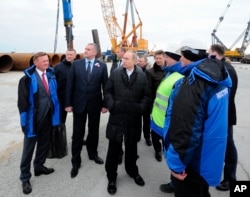With the two-month old cessation of hostilities in Syria rapidly disintegrating, the United States is finding itself in an increasingly uncomfortable position, trying to expand cooperation with Russia while not simultaneously playing into Russia’s hands.
The latest example of Washington’s quandary played out Friday as U.S. and Russian officials worked to reinforce cease-fires in Latakia and Eastern Ghourta, including talks between U.S. Secretary of State John Kerry and Russian Foreign Minister Sergei Lavrov.
“This is not something new but really a constant effort on our part, particularly with the Russians,” a senior State Department official said Friday, adding the status of the northern city of Aleppo was also a deep concern.
“We’re talking to Russia urgently about it in terms of de-escalation and reducing or diffusing tensions there," the official said.
Whether the talks are ultimately successful in averting a worsening humanitarian disaster remains to be seen. But there are significant, lingering doubts that Moscow is interested in anything more than just talks.
“Despite holding back initially, Russian forces in concert with [Syrian President Bashar al] Assad, are violating the cessation of hostilities,” a U.S. intelligence official told VOA.
The official also expressed concerns about the fate of Syria’s largest city, saying Russia “has laid the propaganda groundwork for its support of Syrian regime activities around Aleppo.”
Russia's aims
For weeks, U.S. military and intelligence officials have warned all indications point to an eventual Russian-backed assault on the city. And the recent spike in fighting, described by the United Nations as “monstrous violence,” is reinforcing the notion that what Russian President Vladimir Putin is after is something other than peace.
“They would like a foothold in Syria so they can be a player,” a U.S. official said on the condition of anonymity, noting the Russians already have plenty of military capacity.
“There’s a move to be able to have that long-term capability,” the official added.
Still, Syria seems to be just one part of Russia’s long-term plans.
“Putin’s primary motivation to intervene militarily in Syria was to re-assert Russia’s central place on the world stage,” the U.S. intelligence official said, “escape the international isolation Russia faced after its forced annexation of Crimea.”
Some U.S. officials have downplayed the link between Russian involvement in Syria and Russia’s plans in Ukraine. However, some analysts caution that could be a mistake.
“I think the Russians look at the Middle East as a land of opportunity,” said Reva Goujon, vice president of global analysis at Stratfor, a U.S.-based intelligence company.
“Here is where you have an array of conflicts that threaten to suck the U.S. in at every turn,” she said. “If Russia can insert itself into these conflicts in a big enough way where the United States can’t avoid dealing with Russia to manage those conflicts then that gives Russia some leverage in that broader negotiation.”
Is it working?
For now, at least, it seems the strategy is working with the U.S. forced to deal with Russia in Syria while Washington’s European allies worry about Russia’s involvement exacerbating the migrant crisis.
Yet there have also been some cracks.
One of the biggest has been Russia’s failure to consistently have its proxies on the ground follow its directions. U.S. officials have said the much-hyped Russian announcement of a pullout from Syria was, in large part, meant to send a message to Syrian President Bashar al-Assad. At the time, one official cited Russian frustration with “the intransigence and incompetence of the Syrian regime.”
“The open question is how long Putin will allow Assad to be in charge and put Putin’s gains at risk,” a U.S. intelligence official told VOA.
There is also the complicated relationship between Russia and Iran. Escalating tensions with Turkey could also help to derail Moscow’s plans.
Despite getting the U.S. and its Western allies to the table, Russia has yet to translate its leverage in Syria into concessions on Ukraine or elsewhere in Europe.
“Russia has set up the chess board very well,” said Stratfor’s Goujon. “It’s still a big question on whether they actually get everything they’re hoping for.”











